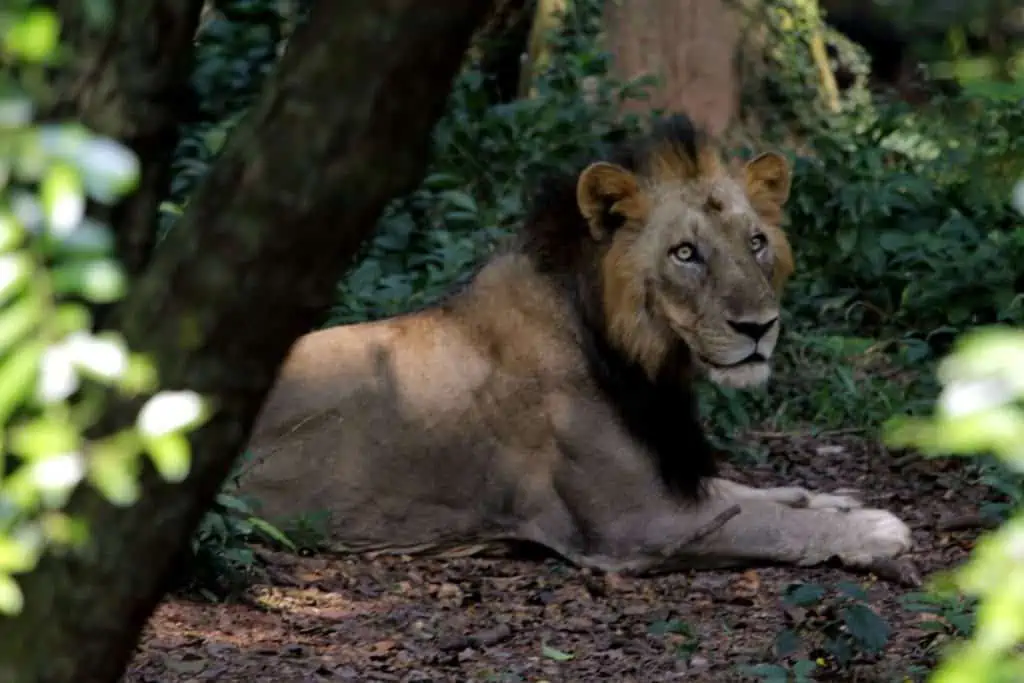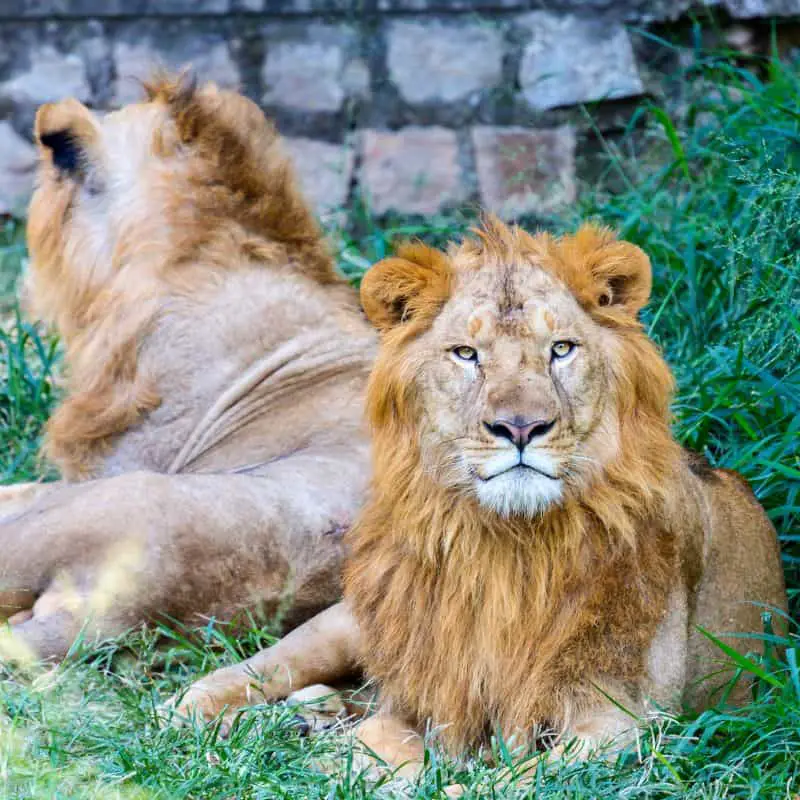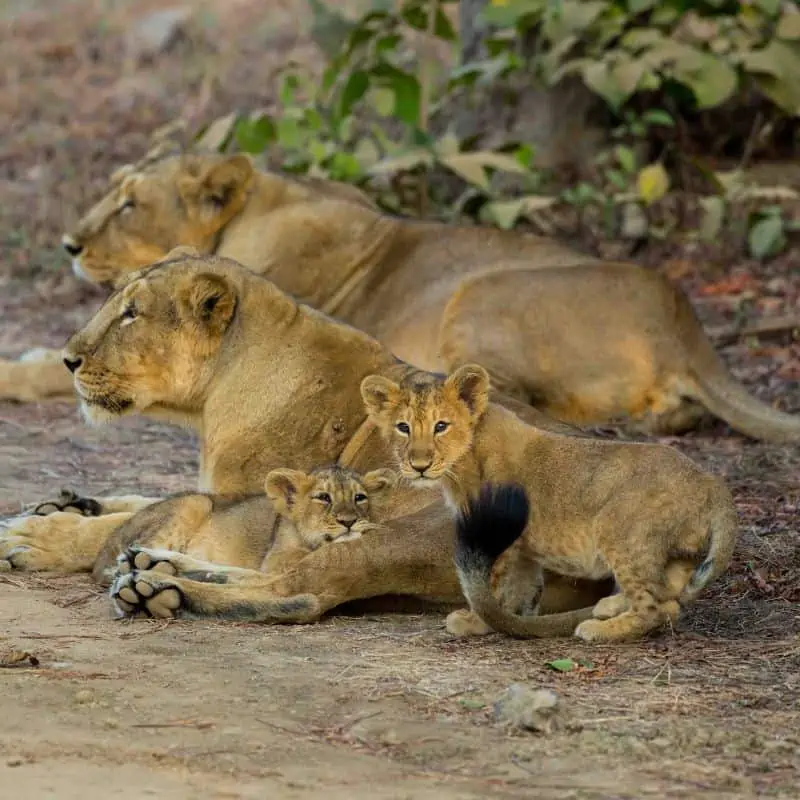Lions are majestic animals, often called the “King of the Jungle.” They boast a large and powerful body, with males typically having an impressive mane. Currently, only two species of lions are left, the African lion and the Asiatic lion. This article will look at the Asian lion in more depth.
Asiatic lions (Panthera leo persica), also known as Indian lions, are an endangered subspecies of lions mainly found in the Gir Forest National Park and Wildlife Sanctuary in Gujarat, India. Historically, its range stretched from Southern Asia to different parts of Europe and North Africa. Its population has declined for centuries due to habitat loss, hunting, and deforestation.

- Top 10 Facts About The Asiatic Lion
- 1. Asiatic Lions Are Found In India
- 2. They Are Smaller Than African Lions
- 3. Their Mane Is Shorter
- 4. Asiatic Lions Have Smaller Prides
- 5. Hunting Style
- 6. They Are Unique
- 7. They Mark Their Territories
- 8. Cubs Are Raised by Every Lioness in the Pride
- 9. They Can Hunt Anything They Want.
- 10. Asiatic Lions Are Endangered
- Final Thoughts On Asiatic Lions
- FAQs
Top 10 Facts About The Asiatic Lion
Asiatic lions are a subspecies of African lions. Thousands of years ago, these lions used to roam around Africa and a few parts of Europe. But as time passed, their population started shrinking and came to the point of extinction in many geographical regions.
The following are some interesting facts regarding Asiatic lions.
1. Asiatic Lions Are Found In India
Asiatic lions are left in very few numbers worldwide and are only found in India’s Gir Forest National Park.
They are a result of environmental adaptability for the past thousands of years. That’s why we see a few physical dissimilarities between African and Asiatic lions.
There used to be a time when these creatures were found in regions across Europe, Africa, and Central Asia. But due to overhunting for their skin and other parts, their population shrunk massively.
2. They Are Smaller Than African Lions
The first and most visible characteristic that differentiates these two species is their size and weight. Asiatic lions are smaller than African lions.
Asiatic lions weigh around 240-420 pounds (110-190 kg), and their body length (excluding the tail) is approximately 6.5 ft (1.98 m). At the same time, their shoulder height can reach up to 1.1m.
African lions are larger and can reach 8.2 ft (2.5 m) without including the tail. They can also weigh up to 420 pounds (190 kg), but females can be much heavier than Asiatic lionesses, managing to weigh up to 40 lb (180 kg).
3. Their Mane Is Shorter
As there is a difference in the size and weight comparison between Asiatic and African lions, Asiatic lions tend to have a shorter mane than African lions.
Asiatic lions have a darker colored mane, usually dark brown, sometimes red. The mane also typically does not extend beyond the neck and shoulders like an African lion.
In contrast, African lions typically have a longer mane, in the typical brown/gold color, which looks more attractive.
There can be a lot of variance in African lion manes though, with dark-colored manes also not being unheard of.

4. Asiatic Lions Have Smaller Prides
Asiatic lions also live in prides, just as African lions do, but Asiatic lions have relatively small prides.
African lions are bigger and have to hunt down larger prey, so they need many pride members. They range from around 2-40 lion members in a pride.
The limited numbers of Asiatic lions can also affect the smaller pride size compared to their African counterparts.
5. Hunting Style
Asiatic and African lions both hunt in a similar manner. But as discussed above, due to smaller pride size, Asiatic lions tend to hunt smaller prey like deer and small buffaloes (as Indian buffaloes are smaller in size than those in Africa).
African Lions, on the other hand, have been seen hunting down giraffes, bison, buffaloes, and even elephants.
Because they have far more lions in their pride, their chances of tackling larger game increase.
6. They Are Unique
Asiatic lions have become unique because they are only found in India. There was a time when these lions were left only in a few dozen numbers, but later on, many organizations joined the conservation project.
They have provided these Asiatic lions a place in Gir Forest, where they are heavily guarded and under constant supervision to hopefully one day recover fully.
7. They Mark Their Territories
Lions are very concerned regarding their territories. They can mark their territories which can consist of many square miles.
For that purpose, they spray or urinate around the area they want to gather, after which other lions of different prides know to stay away.
8. Cubs Are Raised by Every Lioness in the Pride
Cubs, when born in the pride, are raised by all the lionesses in the pride. All the females take care of them, and all the lactating females in the pride feed the cubs.
Lions also play a little part in their upbringing, but their involvement is usually limited to protecting the cubs until they are fully grown.

9. They Can Hunt Anything They Want.
Although Asiatic lions are smaller than African lions, they have been observed hunting larger prey as well.
For example, Asiatic lions often don’t hunt larger prey due to their small size. But when they do, they work together as pride and as a team, for hunting down a buffalo or an elephant.
10. Asiatic Lions Are Endangered
Asiatic Lions are listed as Endangered by the IUCN Red List due to their small population size and the threats they face from poaching, habitat destruction, and inbreeding.
Conservation efforts to protect and increase their population are ongoing, but more work is needed to ensure they can continue to thrive in the wild.
In 2015, the census recorded a total population of 523 individuals, up from 411 in 2010.
This increase demonstrates the success of conservation efforts, but their population is still tiny compared to African lions, which have an estimated 23,000-39,000, according to IUCN.
Final Thoughts On Asiatic Lions
Asiatic lions are one of the most iconic species in India. However, their small population and threat of vulnerability have made them an endangered species. Conservation efforts have had an effect on their population numbers, with a 27% increase noted since 2010.
However, more must be done to ensure the future of these majestic animals in the wild.
With continued conservation measures, the Asiatic lion population can be increased, and their future secured. Our responsibility is to ensure that these creatures continue to thrive in the wild for generations.
FAQs
Where Are Asiatic Lions Found?
Asiatic lions are found in Indian Gir Forest located in Gujrat. They are present in a very small area that is protected from poachers and hunters.
Are Asiatic Lions And African Lions The Same Species?
Yes, both are the same species, although Asiatic lions have adapted to the Indian jungles and have transformed themselves to the geographical region. As a result, they have become smaller over time than African lions.
Are Asiatic Lions Stronger Than African Lions?
No, Asiatic lions are not stronger than African lions. They have smaller bodies and possess less strength than that of African lions.
